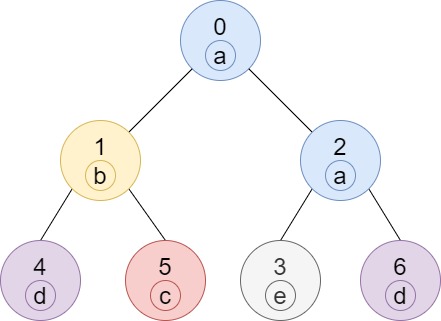Given a tree (i.e. a connected, undirected graph that has no cycles) consisting of n nodes numbered from 0 to n - 1 and exactly n - 1 edges. The root of the tree is the node 0, and each node of the tree has a label which is a lower-case character given in the string labels (i.e. The node with the number i has the label labels[i]).
The edges array is given on the form edges[i] = [ai, bi], which means there is an edge between nodes ai and bi in the tree.
Return an array of size n where ans[i] is the number of nodes in the subtree of the ith node which have the same label as node i.
A subtree of a tree T is the tree consisting of a node in T and all of its descendant nodes.
Example 1:
Input: n = 7, edges = [[0,1],[0,2],[1,4],[1,5],[2,3],[2,6]], labels = "abaedcd" Output: [2,1,1,1,1,1,1] Explanation: Node 0 has label 'a' and its sub-tree has node 2 with label 'a' as well, thus the answer is 2. Notice that any node is part of its sub-tree. Node 1 has a label 'b'. The sub-tree of node 1 contains nodes 1,4 and 5, as nodes 4 and 5 have different labels than node 1, the answer is just 1 (the node itself).
Example 2:
Input: n = 4, edges = [[0,1],[1,2],[0,3]], labels = "bbbb" Output: [4,2,1,1] Explanation: The sub-tree of node 2 contains only node 2, so the answer is 1. The sub-tree of node 3 contains only node 3, so the answer is 1. The sub-tree of node 1 contains nodes 1 and 2, both have label 'b', thus the answer is 2. The sub-tree of node 0 contains nodes 0, 1, 2 and 3, all with label 'b', thus the answer is 4.
Example 3:
Input: n = 5, edges = [[0,1],[0,2],[1,3],[0,4]], labels = "aabab" Output: [3,2,1,1,1]
Example 4:
Input: n = 6, edges = [[0,1],[0,2],[1,3],[3,4],[4,5]], labels = "cbabaa" Output: [1,2,1,1,2,1]
Example 5:
Input: n = 7, edges = [[0,1],[1,2],[2,3],[3,4],[4,5],[5,6]], labels = "aaabaaa" Output: [6,5,4,1,3,2,1]
Constraints:
1 <= n <= 10^5edges.length == n - 1edges[i].length == 20 <= ai, bi < nai != bilabels.length == nlabelsis consisting of only of lower-case English letters.
Related Topics:
Depth-first Search, Breadth-first Search
// OJ: https://leetcode.com/problems/number-of-nodes-in-the-sub-tree-with-the-same-label/
// Author: github.com/lzl124631x
// Time: O(N)
// Space: O(N)
class Solution {
vector<vector<int>> G;
vector<int> ans, seen;
vector<int> dfs(int u, string &labels) {
seen[u] = 1;
vector<int> cnt(26, 0);
for (int v : G[u]) {
if (seen[v]) continue;
auto sub = dfs(v, labels);
for (int i = 0; i < 26; ++i) cnt[i] += sub[i];
}
cnt[labels[u] - 'a']++;
ans[u] = cnt[labels[u] - 'a'];
return cnt;
}
public:
vector<int> countSubTrees(int n, vector<vector<int>>& E, string labels) {
G.assign(n, {});
ans.assign(n, 0);
seen.assign(n, 0);
for (auto &e : E) {
G[e[0]].push_back(e[1]);
G[e[1]].push_back(e[0]);
}
dfs(0, labels);
return ans;
}
};

